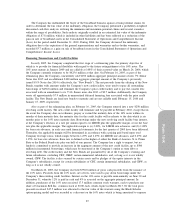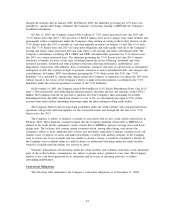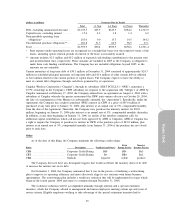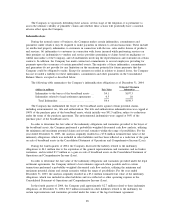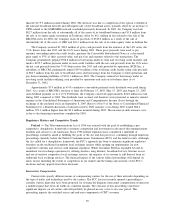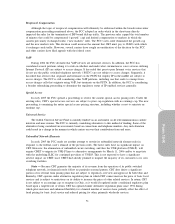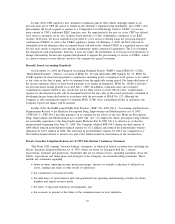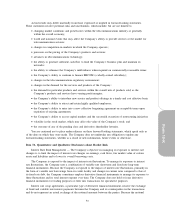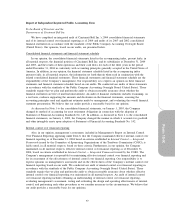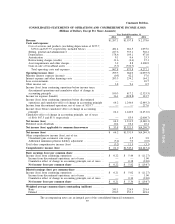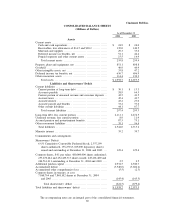Cincinnati Bell 2004 Annual Report Download - page 124
Download and view the complete annual report
Please find page 124 of the 2004 Cincinnati Bell annual report below. You can navigate through the pages in the report by either clicking on the pages listed below, or by using the keyword search tool below to find specific information within the annual report.than the $175.9 million incurred during 2002. The decrease was due to completion of the optical overbuild of
the national broadband network and subsequent sale of the broadband assets, partially offset by an increase at
CBW related to the GSM/GPRS network overbuild previously discussed. In 2003, the Company received
$82.7 million from the sale of substantially all of the assets of its broadband business and $3.8 million from
the sale of its entire equity investment in Terabeam, offset by $6.1 million in fees related to the sale of the
BRCOM assets. In 2002, the Company received proceeds of $345.0 million as a result of the sale of
substantially all of the assets of CBD and $23.3 million from the sale of its entire equity stake in Anthem Inc.
The Company received $1,390.0 million of gross cash proceeds from the issuance of the 16% notes, the
7
1
⁄
4
% Senior notes due 2013 and the 8
3
⁄
8
% notes during 2003. These gross proceeds were used to pay
amounts outstanding under the credit facility, purchase the Convertible Subordinated Notes at a discounted
price equal to 97% of their accreted value, and pay fees and expenses related to the transactions. The
Company permanently prepaid $708.8 million in borrowings under its term and revolving credit facilities and
made a $195.7 million payment under its term credit facilities with the net cash proceeds from the 16% notes,
the net cash proceeds from the 7
1
⁄
4
% Senior notes due 2013 and cash provided by operations. BCSI Inc., a
subsidiary of BRCOM, permanently repaid $193.0 million of the revolving credit facility using cash proceeds
of $82.7 million from the sale of broadband assets and borrowings from the Company to fund operations and
pay down remaining liabilities of $110.3 million in 2003. The Company reduced its borrowings under its
revolving credit facilities utilizing cash provided by operations and cash on its balance sheet as of
December 31, 2002.
Approximately $7.9 million in 6
3
⁄
4
% cumulative convertible preferred stock dividends were paid during
2003. As a result of BRCOM’s decision to defer the February 15, 2003, May 15, 2003 and August 15, 2003
cash dividend payment on its 12
1
⁄
2
% Preferreds, the Company conserved approximately $24.8 million in cash
during 2003 compared to 2002. The dividends were accrued, and therefore were presented as minority interest
expense in the Consolidated Statements of Operations and Comprehensive Income (Loss) through the
exchange of the preferred stock on September 8, 2003. Refer to Note 9 of the Notes to Consolidated Financial
Statements for a detailed discussion of minority interest. Debt issuance costs during 2003 totaled $80.4
million, $71.2 million higher than the $9.2 million incurred during 2002. The increase in debt issuance costs
is due to the financing transactions completed in 2003.
Regulatory Matters and Competitive Trends
Federal — The Telecommunications Act of 1996 was enacted with the goal of establishing a pro-
competitive, deregulatory framework to promote competition and investment in advanced telecommunications
facilities and services to all Americans. Since 1996 federal regulators have considered a multitude of
proceedings ostensibly aimed at fulfilling the goals of the Act and this process is continuing through numerous
proceedings currently before the Federal Communications Commission (FCC) and the federal courts. Although
the Act called for a deregulatory framework, the FCC’s approach has been to maintain significant regulatory
restraints on the traditional incumbent local exchange carriers while opening up opportunities for new
competitive entrants and services with minimal regulation. While Cincinnati Bell has expanded beyond its
incumbent local exchange operations by offering wireless, long distance, broadband service, Internet access
and out-of-territory competitive local exchange services, the majority of its revenue is still derived from its
traditional local exchange services. The financial impact of the various federal proceedings will depend on
many factors including the extent of competition in our market and the timing and outcome of the FCC’s
decisions and any appeals from those decisions.
Intercarrier Compensation
Current rules specify different means of compensating carriers for the use of their networks depending on
the type of traffic and technology used by the carriers. The FCC has just recently opened a proceeding to
consider various plans that have been proposed for revising the disparate intercarrier compensation system into
a unified regime that treats all traffic in a uniform manner. The outcome of this proceeding could have
significant impacts on all carriers and will probably be phased-in over a five to ten year period. This
proceeding impacts the switched access and end-user components of CBT’s revenue.
50





